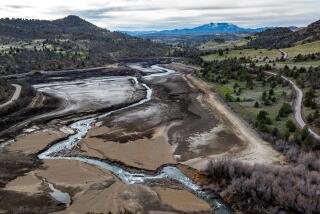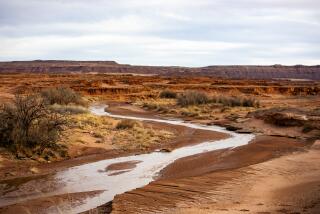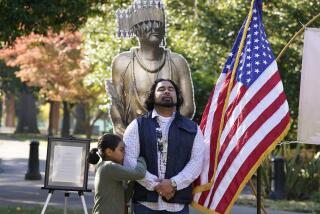Indians Dreaming of Water for Their Suffering Soil
SACATON, Ariz. â If he closes his eyes and shuts out the miles of fallow fields that yield only brush and shriveled mesquite, Harlan Bohnee can still see when this valley thrived.
Neat rows of cotton camouflaged the desert, painting the dusty earth an emerald green. Peach trees and wild spinach sprouted outside his boyhood home, in the shadow of mountains covered with cactus.
Families like his lived off the land, and the land obliged with a bounty that sustained the cultural and economic existence of a community whose very name means âRiver People.â His ancestors settled there because of the life-giving waters that flowed freely into hand-dug aqueducts.
âThat was the basis for our culture -- the river,â said the 66-year-old farmer, who learned the trade from his father, who learned from his father. âIf you donât have water, you donât have anything. Youâre not even living.â
If you ask Bohnee, the Gila River Indian Community hasnât really been alive for years.
Its watershed, like those traversing so many of the nationâs Indian reservations, was drained after white settlers headed West and began pumping the river for their own use. Farmland went barren. Irrigation canals dried up and became littered with weeds and trash. Self-sufficiency eroded with the shrinking river as the tribe grew more reliant on government commodities.
Today, Bohnee is one of only a handful of farmers on the 370,000-acre reservation, which sits south of Phoenix along swelling suburbs whose golf courses and houses serve as the Indiansâ competitors for water.
But now he sees promise in the neglected soil that spans his homeland.
One proposal would guarantee the community of 17,000 Indians about 2.1 billion gallons of water each year -- enough to serve roughly 3 million people -- and give the tribe $200 million in federal money to rebuild its dilapidated irrigation system.
The deal is one of dozens of Indian water settlements in negotiation over the last 25 years as Western states, the federal government, farmers, industries and tribes seek to sort out who should get how much of the regionâs most precious resource. Congressional action would be required.
The Gila River proposal, among the largest in terms of how much water would be awarded, comes as the battle for liquid gold reaches new heights in the West. With severe drought draining rivers and reservoirs, some towns ran dry this summer while neighbors waged war over century-old water rights.
For non-Indians, the settlements mean certainty about how much water theyâre due in wet times or dry. For the tribes, they carry the prospect of economic development and, for some, a return to traditional agricultural practices.
They also bring newfound bargaining power to a group that has always had little.
âThese water settlements are the treaties of this century, the way the land settlements were the treaties of last century,â said Daniel McCool, director of the University of Utahâs American West Center who has written several books on Indian water settlements. âThey are critically important and will have profound consequences for Indian country for all future generations to come.â
White settlers saw the Westâs streams and rivers as their sole domain and dug canals to irrigate arid pastures. They also developed a new legal system to delineate water rights: Whoever first diverted and used the water had the right to that resource over all subsequent claimants.
But their doctrine of âprior appropriation,â meant to serve the miners, ranchers and farmers who became the prevailing political forces in the West, faced an unlikely challenge from their old adversaries.
In 1905, a Justice Department attorney in Montana filed suit on behalf of the Ft. Belknap Indian Reservation, seeking water for a proposed irrigation project. He argued that when the U.S. established the reservation, it implicitly reserved the right to enough water to sustain the land.
Although the position was contrary to prior appropriation, a judge agreed. Three years later, the U.S. Supreme Court upheld the ruling.
But these victories rarely resulted in actual water for the reservations because few had any modern delivery systems or the money to construct them. With their land held in trust by the government, Indians couldnât obtain bank loans to build irrigation canals, and Congress was slow to fork over cash.
One by one, tribes began asserting their water rights in court -- sometimes suing independently, sometimes intervening in cases brought by states or non-Indians. A few early settlements were reached in the 1960s, but once again, promises of water delivery went unfilled. By the late 1970s, court rulings turned less favorable for the tribes, including one giving state courts the authority to resolve claims.
With leaders concerned about the impact of Indian claims on future development and tribes worried that they couldnât win in court, the federal government began calling on all sides to negotiate.
In 1978, the 750-member Ak-Chin Indian tribe, just south of the Gila River reservation, became the first Indian community to settle its claims under the federal negotiating process.
Approved by Congress in 1984, the settlement mandated delivery of 75,000 acre-feet of water annually to the reservation beginning in 1988. It also allowed the community to lease another 10,000 acre-feet annually to provide water for a development north of Phoenix. (One acre-foot is about 326,000 gallons, enough to cover an acre of land with a foot of water.)
Tribal member Leona Kakar began fighting for the deal in the 1960s, when she and her brothers came up with the idea of starting a farm to sustain the community. Before water arrived, the Ak-Chin farmed just 3,000 acres. They now grow 15,000 acres of wheat, barley and cotton.
Seventeen settlements have been approved since. Twenty more remain in negotiation, and other tribes await their chance to bargain.
Not every tribe wants the water for farming. Some seek to protect streams and species they consider sacred. Others have use for the water and intend to lease it back to non-Indian users, something opponents fear will result in a high-stakes bidding war. In return for the settlement, tribes agree to waive all future claims to their federal reserved water rights.
But the process is hardly without strife. Settlements involve nearly every significant watershed in the West and thousands of users. Some negotiations last for decades -- the Gila River case began in 1974 -- and are fraught with some of the same underlying attitudes that plagued early white-Indian relations.
Even those who support the settlements donât agree with the rationale behind them.
âIt just seems unfair ... like their rules are always different than our rules,â said Arizona cotton farmer Dan Thelander, who would surrender some water rights under the proposed Gila River settlement. In exchange, farmers would be exempt from paying millions in water-related debts and have the opportunity to buy other water at a cut rate.
âTheyâre going to get water when they werenât using it before and everybody else had to use it. They got the casinos, and nobody else can have casinos,â he said. âPhilosophically, I donât really think that they deserve it. But the reality is that itâs too good a deal to pass up.â
Thatâs what the Gila River Indians are counting on. The community is fast at work building irrigation canals that leaders hope will one day carry water to now-fallow fields. The ultimate goal is to raise 146,000 acres of cotton, wheat, alfalfa and vegetables.
âPeople say, âWhy do you want a water settlement when all this is desert?â Well, it wasnât this way,â Bohnee said. âItâs basically dead right now. It needs to be brought back to life.â
Now when Bohnee surveys his homeland, he no longer dwells in the past. He can finally envision a future.
More to Read
Sign up for Essential California
The most important California stories and recommendations in your inbox every morning.
You may occasionally receive promotional content from the Los Angeles Times.










